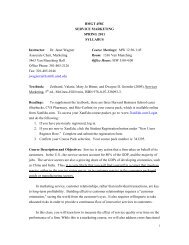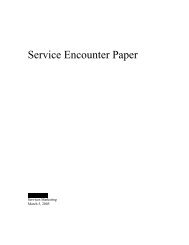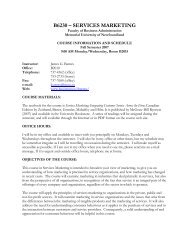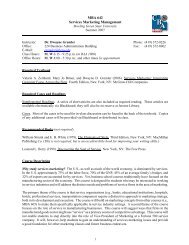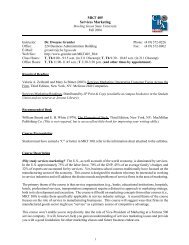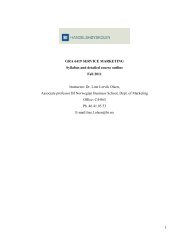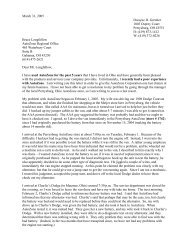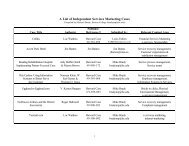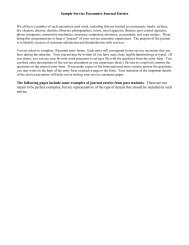Rapport-Building Behaviors Used by Retail Employees - Gremler.net
Rapport-Building Behaviors Used by Retail Employees - Gremler.net
Rapport-Building Behaviors Used by Retail Employees - Gremler.net
Create successful ePaper yourself
Turn your PDF publications into a flip-book with our unique Google optimized e-Paper software.
D.D. <strong>Gremler</strong>, K.P. Gwinner / Journal of <strong>Retail</strong>ing 84 (3, 2008) 308–324 309nonrecurring retail interactions (Bitner and Hubbert1994; Rust and Oliver 1994), most research focusing oncustomer–employee interactions refers to repeated interactions(cf. Goodwin and <strong>Gremler</strong> 1996; Gwinner, <strong>Gremler</strong>, and Bitner1998; Reynolds and Beatty 1999). Because rapport applies tomany retail situations, and therefore is useful in both recurringand nonrecurring retail encounters, it provides a versatile andimportant construct for retailers (cf. DeWitt and Brady 2003;<strong>Gremler</strong> and Gwinner 2000).This research attempts to identify the specific rapportbuildingbehaviors often present in retail interactions.Specifically, we conduct a study to investigate the followingquestion: Are the same rapport-building behaviors that markinterpersonal interactions also used <strong>by</strong> retail employees in serviceencounters? Toward this end, we first review relevantrapport research published primarily in the social psychologyliterature. Next, we discuss the results of a study designed toidentify rapport behaviors used in retail service encounters.Finally, we discuss the managerial and research implicationsderived from our findings.<strong>Rapport</strong> conceptualization and behaviorsThe construct of rapport has been the subject of studies in avariety of contexts and conceptualized in many different, thoughrelated, ways. For example, in a supervisor–subordinate context,rapport refers to “communication characterized <strong>by</strong> warmth,enthusiasm, and interest” (Heintzman et al. 1993, p. 200). In thearea of conflict mediation, rapport building entails the effortsused to create “more harmonious interaction between the parties”(Ross and Wieland 1996, p. 229). In the context of therelationship between a caregiver and a person with developmentaldisabilities, rapport is discussed in terms of the “quality of therelationship between two people” (McLaughlin and Carr 2005,p. 69). Finally, in the linguistics field, Spencer-Oatey (2002)conceptualizes rapport as social interactions with a particularlynoticeable impact on a relationship with another person. We citethese four studies not to suggest that one conceptualization ofrapport is correct and another is incorrect but rather to illustratethe varied and context-specific nature of the construct.Altman (1990) acknowledges the socially contextual natureof rapport and suggests that what constitutes and influences thedevelopment of rapport depends at least partially on the peopleinvolved and the context in which they interact. Altman alsocontends that in addition to these social influences, the physicalenvironment (e.g., public vs. private settings) that embeds therelationship influences the rapport process. Therefore, given theimpact of the social context and the environmental setting on thenature of rapport, we examine rapport in commercial (retail) contexts.Examining how rapport-building behaviors employed inother contexts, such as personal relationships or doctor–patientinteractions, may function in retail contexts provides the maincontribution of this research.To study rapport in a retail context, we define customer–employee rapport as the perceived quality of the relationship,dealing with the communication between the two parties andcharacterized <strong>by</strong> a connection or understanding among the participants.The rapport-building behaviors discussed in the nextsection and those identified in the empirical study are notdimensions of rapport but instead represent employee behaviorsenacted to increase a customer’s rapport perceptions. On thebasis of an extensive review of rapport across various contexts –ranging from education to roommates to therapists to personalselling – and a series of in-depth interviews with both consumersand service providers, <strong>Gremler</strong> and Gwinner (2000) exami<strong>net</strong>wo dimensions of rapport in commercial service encounters:(1) enjoyable interactions involving (2) personal connectionsbetween the participants. This “commercial rapport” conceptualizationis consistent with the view of rapport in other contexts.For example, in their often-cited article on the nature of rapport,Tickle-Degnen and Rosenthal (1990) describe three componentsthat characterize relationships with a high level of rapport.Their “mutual attentiveness” and “positivity” components suggestrapport is higher in interactions in which the participants areinterested in each other and share a feeling of caring or friendliness.These two elements also appear in <strong>Gremler</strong> and Gwinner’soperationalization of the enjoyable interaction dimension of rapport.Tickle-Degnen and Rosenthal’s third element, coordination(participants are “in sync”), is reflected in <strong>Gremler</strong> and Gwinner’spersonal connection dimension of rapport.<strong>Gremler</strong> and Gwinner’s (2000) study suggests that rapporthas a positive relationship with customer perceptions of satisfaction,loyalty, and positive word-of-mouth communication ina retail bank context. Likewise, we view a customer’s rapportperceptions as antecedents of service quality. Recent servicequality conceptualizations have brought increased attention tointeraction quality as an element of a higher-order service qualityconstruct (Brady and Cronin 2001). We suggest that enjoyableinteractions that establish a personal connection positivelyinfluence Brady and Cronin’s interaction quality factor and, subsequently,service quality. Just as Altman (1990) argues thatresearchers should account for the contextual impact (e.g., commercialsetting) when evaluating rapport, others suggest the needto consider context when evaluating service quality (Brady andCronin 2001). Dabholkar, Thorpe, and Rentz (1996) offer acontext-specific hierarchical model of retail store service qualitywhich – similar to Brady and Cronin’s work – highlightspersonal interaction as a factor of service quality. Their personalinteraction dimension combines employee behaviors thatinspire confidence and are courteous. Although the personal connectiondimension of rapport is similar to the service qualityconstructs proposed <strong>by</strong> Brady and Cronin (2001) and Dabholkaret al. (1996), the notion of a personal connection between participantsmakes the rapport construct unique and different fromthe proposed subdimensions of service quality.A variety of strategies or techniques for building rapportappear in social psychology and communication literature(Andersen and Guerrero 1998; Bernieri et al. 1996; Fordand Etienne 1994; Lakin and Chartrand 2003; Thompson1998; Tickle-Degnen and Rosenthal 1987; Tickle-Degnen andRosenthal 1990), yet few studies examine whether the samerapport-building behaviors are used and/or applicable in commercialsettings (cf. Bendapudi and Leone 2002; DeWitt andBrady 2003; <strong>Gremler</strong> and Gwinner 2000). We therefore review



